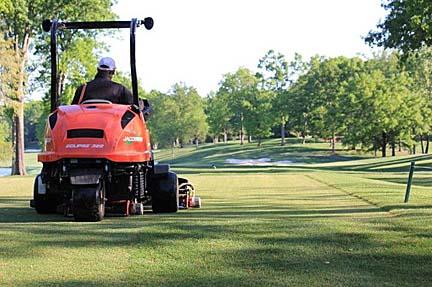 Repair work to some of the greens at the home of the PGA Tour's Wells Fargo Championship might appear patchy on TV during this year's tournament, but that look should be nothing more than a cosmetic distraction to viewers at home, according to a turfgrass researcher who has spent years monitoring conditions at Quail Hollow Club.
Repair work to some of the greens at the home of the PGA Tour's Wells Fargo Championship might appear patchy on TV during this year's tournament, but that look should be nothing more than a cosmetic distraction to viewers at home, according to a turfgrass researcher who has spent years monitoring conditions at Quail Hollow Club.Two of the aging Penn G-2 bentgrass greens at the course in Charlotte, N.C., have been sodded twice in the past three weeks to replace patches of thinned turf. The most recent repair work was performed on April 22, just nine days before the first round of the tournament scheduled for May 1-5.
Since then stories have circulated about the quality of the greens at Quail Hollow, with accounts of club members blaming PGA Tour agronomists for conditions, and a Tour official discounting those accusations. Andy Pazder, the PGA Tour's chief of operations, admitted in published reports that conditions on Nos. 8 and 10 were not up to snuff, necessitating new sod, but went on to say the damage was not the fault of Tour agronomists.
While members take shots at the Tour, Fred Yelverton, Ph.D., professor of crop science at North Carolina State University, said that blame is misguided. The culprit, he said, is a turfgrass variety ill suited for conditions at Quail Hollow.
Yelverton has been working with Quail Hollow superintendents since 1995. He said the two greens in question, as well as the 16 others, should be just fine for the tournament. He and fellow NC State professor Grady Miller, Ph.D., are working with Quail Hollow superintendent Chris Deariso and Tour agronomists to ensure playing conditions worthy of a PGA Tour event.
"All these problems are overstated," Yelverton said. "The greens are going to be just fine."
Although G-2 is a proven performer on many courses around the country for its improved shoot density, overall turf quality and disease resistance, it has been an awkward fit at Quail Hollow, where heat stress prevails for much of the year.
In the 16 years that Quail Hollow superintendents have been growing G-2, segregation has been a consistent problem, resulting in stressed turf, occasional turf loss in random patterns and an overall weakened stand that Yelverton said has become nearly unmanageable. The segregation of G-2 has resulted in contamination from Poa annua, other bentgrass varieties and even some Bermudagrass, and its response to even the most basic management practices has been erratic.
And while some headlines give the illusion the tournament might be decided upon patches of barren soil, Yelverton said conditions could have been far worse if not for the expertise of Deariso and those same PGA Tour agronomists with whom others cast blame.
"They've done an outstanding job," Yelverton said.
"I've been looking at these greens for years, and I've never seen turf segregate like G-2 has at Quail Hollow. And this is key to what everyone with a non-agronomic background is talking about. Because of that segregation, the (G-2's) response to any normal agronomic practice has been unpredictable. I've seen little patches 6 to 8 inches wide turn yellow and die from heat stress while the other 99 percent of the green is fine. And I've never seen that before, and I've never seen it anywhere other than (at Quail Hollow)."
Enough was left from the 42-inch-by-60-foot rolls of sod that some cosmetic work was performed on roll-off areas on Nos. 12 and 13.
Any problems associated with managing G-2 at Quail Hollow, however, soon will be a thing of the past.
Talk of a restoration has swirled for years at Quail Hollow, which last year was named the site of the 2017 PGA Championship. That much-needed restoration will begin later this year and will include regrassing the putting surfaces with an ultradwarf Bermudagrass, probably Champion or MiniVerde, that is better suited for August conditions in North Carolina.
"Everybody involved realized that needed to be done. It was a matter of when it was going to be put on the calendar," Yelverton said. "It wasn't a matter of if, it was a matter of when."
In the meantime, work will focus on rolling the newly sodded greens to ensure a smooth playing surface and minimal sod seams for this year's tournament. Yelverton said Stimpmeter readings for the tournament should be in the range of 10-11 feet, which is plenty of speed for Quail Hollow's undulating greens.
"Everyone needs to move on and enjoy the tournament because it's going to be a good one," Yelverton said. "I'm sure whoever wins on Sunday will think the greens putted just fine."

